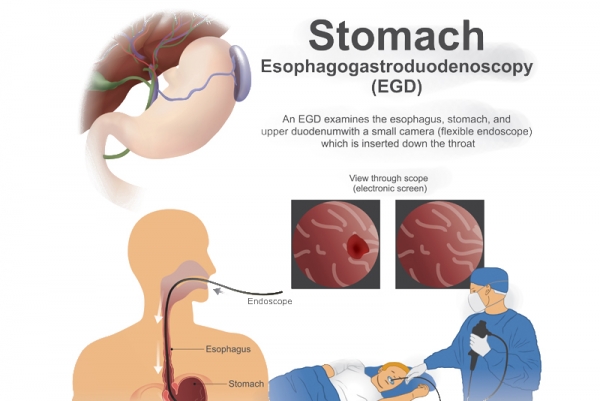Upper GI endoscopy is a procedure that uses a lighted, flexible endoscope to see inside the upper GI tract. The upper GI tract includes the esophagus, stomach, and duodenum—the first part of the small intestine.
What is Upper Gastrointestinal (GI) Endoscopy? Upper GI endoscopy is a procedure that uses a lighted, flexible endoscope to see inside the upper GI tract. The upper GI tract includes the esophagus, stomach, and duodenum— the first part of the small intestine.
What problems can an Upper GI Endoscopy detect? Upper GI endoscopy can detect, ulcers, abnormal growths, precancerous conditions, bowel obstruction, inflammation, and hiatal hernia.
When is an Upper GI Endoscopy used? Upper GI endoscopy can be used to determine the cause of: abdominal pain, nausea, vomiting, swallowing difficulties, gastric reflux, and unexplained weight loss.
How to Prepare for an Upper GI Endoscopy: The upper GI tract must be empty before an Upper GI Endoscopy can be performed. Generally, no eating or drinking is allowed for 8 hours before the procedure. Smoking and chewing gum are also prohibited during this time. Patients should tell their doctor about all health conditions they have – especially heart and lung problems, diabetes, and allergies— and all medications they are taking. Patients may be asked to temporarily stop taking medications that affect blood clotting or interact with sedatives, which are often given during an Upper GI Endoscopy.
Medications and vitamins that may be restricted before and after upper GI endoscopy include blood thinners and diabetes medications. Driving is not permitted for 12 to 24 hours after upper GI endoscopy to allow sedatives time to completely wear off. Before the appointment, patients should make plans for a ride home.
How is an Upper GI Endoscopy performed? Patients may receive a local, liquid anesthetic that is gargled or sprayed on the back of the throat. The anesthetic numbs the throat and calms the gag reflex. An intravenous (IV) needle is placed in a vein in the arm if a sedative will be given. Sedatives help patients stay relaxed and comfortable. While patients are sedated, the doctor and medical staff monitor vital signs. During the procedure, patients lie on their back or side on lence, we give our patients the comfort of clarity.

